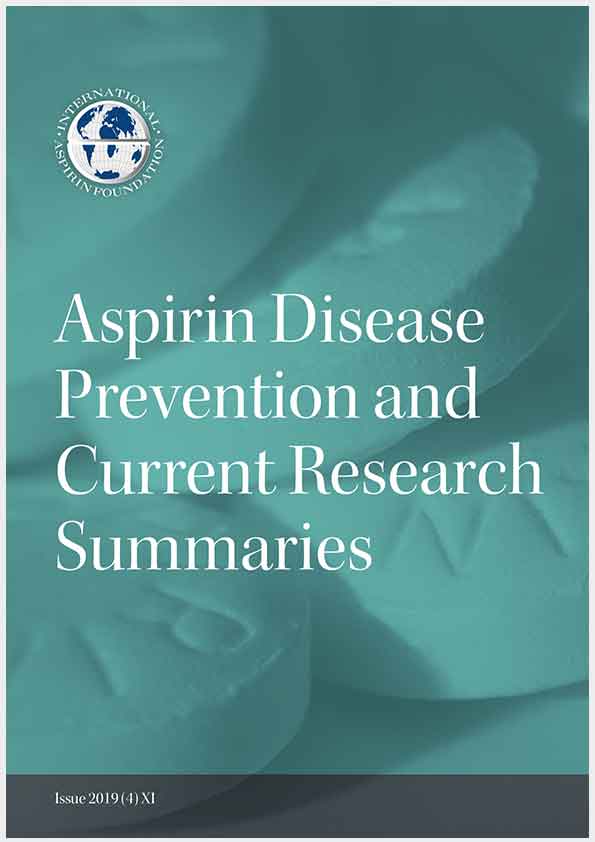SeAFOod Polyp Prevention trial: the effects of aspirin and eicosapentaenoic acid, alone or in combination, for the prevention of colorectal adenomas.
The SeAFOod polyp prevention trial was set up to investigate the effect of aspirin and the omega-3 polyunsaturated fatty acid eicosapentaenoic acid (EPA), alone and in combination, compared with placebo for the prevention of colorectal adenomas in individuals with sporadic colorectal neoplasia detected at colonoscopy. This is an important study because despite improved detection and treatment colorectal cancer is a leading cause of cancer death in the UK. Post-colonoscopy colorectal cancers, particularly right sided colon cancer, still occur and a safe and effective method of chemoprevention for colorectal cancer is needed.
SeAFOod a multi-centre, randomised, double-blind, placebo controlled, 2 x 2 factorial trial followed patients aged 55-73 years who were identified during colonoscopy in the English Bowel Cancer Screening Programme (BCSP) as being of high risk. High risk was categorised as greater or equal to 3 adenomas if at least one was greater or equal to 10 mm in diameter or greater or equal to 5 adenomas if these were less than 10 mm in diameter. The study took place between November 11 2011 and June 10th 2016 and 709 participants were randomly assigned to the four treatment groups. A dose of 300 mg of aspirin daily was used.
The study found no evidence that either EPA or aspirin treatments reduced the proportion of individuals with one or more colorectal adenoma at 12 months surveillance colonoscopy in this BSCP classified high risk group. The adenoma detection rate (ADR) was the primary endpoint
for this study. When further analysis was carried out aspirin was found to be effective at reducing the total number of adenomas per participant and both aspirin and EPA appeared to have sub-type and site- selective effects. It was interesting to see that participants receiving aspirin had a reduction in the number of adenomas found in the right colon, in particular serrated adenomas but also a reduced risk of conventional colorectal adenomas. The safety of both agents was described as excellent with an excess of mild to moderate gastrointestinal adverse events in the EPA group.
The authors question the use of ADR as a chemoprevention biomarker in high risk patients who are undergoing quality-assured colonoscopy for assessment and suggest that colorectal adenoma number per participant may be a better measure with which to assess chemopreventative effects. They also recommend that future chemoprevention trials should stratify by colorectal adenoma subtype and tumour location. Further research is advised to investigate the effect of aspirin and or EPA on colorectal adenoma number in terms of adenoma type and location. They advocate for a precision medicine approach to adenoma recurrence and the use of chemoprevention.
The authors conclude “Existing data on colorectal cancer risk reduction by aspirin suggest that the decrease in colorectal adenoma recurrence that we report for both agents is likely to translate into a clinically meaningful decrease in long-term colorectal cancer risk.”
For further information please see:
Hull MA, Sprange K and Hepburn T, et al. Eicosapentaenoic acid and aspirin, alone and in combination, for the prevention of colorectal adenomas (seAFOod Polyp Prevention trial): a multicentre, randomised, double-blind, placebo-controlled, 2 x 2 factorial trial. The Lancet 2018; November 19, http://dx.doi.org/10.1016/S0140-6736(18)31775-6
The ARRIVE Study: Aspirin to reduce the risk of initial vascular events in those at moderate risk of cardiovascular disease.
The ARRIVE study aimed to assess the safety and efficacy of aspirin for the primary prevention of cardiovascular events in people with no previous history of a cardiovascular event that are deemed at moderate risk of cardiovascular disease (CVD). Although the role of aspirin in the secondary prevention of cardiovascular disease is well established in people who have already suffered a cardiovascular event the risk benefit ratio is less clear in the primary prevention of CVD.
This randomised, double-blind, placebo-controlled, multicentre study carried out in seven countries at 501 study sites followed the effect of taking aspirin 100 mg enteric-coated daily versus placebo in 12546 patients (men aged 55 years and older and women 60 years and older) who were judged by a set of specific risk factors to be at moderate risk of CVD. Patients who were at high risk of bleeding or who had diabetes were excluded. A composite outcome of the time to first occurrence of a CVD event (cardiovascular death, myocardial infarction, unstable angina, stroke or TIA) was the key primary outcome and safety endpoints included time to a haemorrhagic event. The median follow up of the patients was 60 months.
Aspirin treatment was not found in ARRIVE to lower the risk of a major CVD event in this population, stroke incidence did not differ between treatment and placebo arms but similar to other published low- risk primary prevention studies the risk of having an MI was lower in the aspirin group but this only reached statistical significance in the per-protocol analysis. None of the secondary end points were significant.
ARRIVE illustrates the difficulties in undertaking long-term primary prevention studies in the current era of aggressive management of CVD risk factors e.g. cholesterol, blood pressure etc. In ARRIVE 43% of patients were taking statins which can be considered the norm in this moderate CVD risk population.
In addition within the study there were some complexities around gathering event data. The differences seen between the intention-to treat and per-protocol analysis for MI could have been due to the fact that if a patient developed stable angina they would receive non-study aspirin and other intense management and follow up which lowered the risk of developing an MI. A decision to include TIA and stable angina in the primary endpoints did not however alter the results. Overall the event rate in ARRIVE was lower than expected and the group of patients who were selected for what was estimated to be a moderate risk of CVD in fact turned out to be low CVD risk group. Compliance was another issue and this may have been influenced by media reports in the UK at the time of the study. Meta-analysis of previous primary prevention studies show similar results to ARRIVE in that aspirin reduces the risk of MI but does not reduce the risk of stroke or all-cause vascular death.
Gastrointestinal bleeding events and some minor bleeding events were higher in the aspirin arm of the study but no significant difference in fatal events was seen. The follow-up of the study was not long enough to show benefit in terms of cancer prevention.
The authors to this study conclude that decisions around the use of aspirin in the primary prevention of CVD need to result from a careful discussion of risks and benefits between the clinician and the patient. This discussion can weigh up the potential cardiovascular and cancer benefits of aspirin use with bleeding risks, patient preferences and cost etc. the data from ARRIVE and other studies can be used to help inform the discussion and shared decision making between clinician and patient of their unique perspective of the balance between potential risks and benefits achieved.
For further information please see:
Gazinano MJ, Brotons C and Coppolecchia R, et al. Use of aspirin to reduce risk of initial vascular events in patients at moderate risk of cardiovascular disease (ARRIVE): a randomised, double-blind, placebo-controlled trail. Lancet 2018; 392:1036-1046.
Review of observational studies supporting aspirin’s role in cancer treatment
Interest in platelet-tumour interactions was reported as early as 1973 in the International Journal of Cancer. Experimental evidence is now able to demonstrate how platelets and coagulation pathways protect tumour cells from the immune system and enable them to attach to vascular endothelium and enhance metastatic spared. A recent paper by Professor Elwood and colleagues reviews the evidence up to August 2017 around the use of low dose aspirin in people with a diagnosis of cancer. A meta-analyses of 71 studies was performed with pooled data covering over 120 000 patients with cancer taking aspirin.
Of the studies included 29 observational studies explored colorectal cancer and post-diagnostic aspirin use, fourteen reported on aspirin and breast cancer and 16 looked at aspirin and prostate cancer. There is also data from 12 other cancer types. Ten of the studies in the meta-analysis also included evidence about metastatic spread.
The nature of observational studies limits the strength of the evidence and randomised controlled trials (RCTs) are now underway with aspirin as an adjunct cancer treatment but it will be 10 years or so before this data is available. As such this meta-analysis of the observational trials presents an important opportunity to start a discussion around whether there is now sufficient evidence to justify a recommendation to consider low-dose aspirin for cancer treatment.
The observational data for colorectal cancer suggests that aspirin is associated with a reduction in colorectal cancer mortality of around 25% and a probable reduction in metastatic spread. There may however be some publication bias in the data available.
The data for breast cancer also shows a 20% reduction in breast cancer mortality as well as a significant reduction in the incidence of metastatic spread. Evidence for a reduction in all-cause mortality is also suggested by the available data.
In addition prostate cancer studies also indicate a reduction in prostate cancer of around 15% as well as a reduction in all-cause mortality. One study was inconsistent with this but it has not been possible to find out the reason for this difference.
The authors conclude that whilst it is important to get data from RCTs and to weight up the risks and benefits of aspirin; “These results give extensive evidence consistent with reductions of about 15-25% in cancer mortality by aspirin.” and call for more discussion and a wider spread of knowledge about aspirin and cancer.
For further information please see:
Elwood PC, Pickering JE, Morgan G et al. Systematic review update of observational studies further supports aspirin role in cancer treatment: Time to share evidence and decision-making with patients? PLOS/ONE September 25th 2018 https://doi.org/10.1371/journal.pone.0203957
Commentary ASPREE: Aspirin and Cancer Prevention in the Elderly: Where do we go from here?
Professors Andrew Chan and John McNeil provide an insightful commentary, currently in press with Gastroenterology, in which they discuss the results of the recently reported ASPREE trial in the context of pre-existing evidence and support for the effectiveness of aspirin as a primary prevention agent for cardiovascular disease (CVD) and cancer.
Within the commentary they explore 5 possible hypotheses which include variation in the effect of aspirin depending on the timing of exposure, the age of the individual taking it or other risk factors they may have for cancer and where ASPREE sits within the body of existing evidence.
They conclude:
“The contrary results of ASPREE compared with prior RCTs are humbling. It was perhaps naïve to assume that a preventative agent would offer a uniform effect across a broad population.”
For further information please see:
Gastroenterology, published by Elsevier (2018), below: https://doi.org/10.1053/j.gastro.2018.11.063 N.B This is the uncorrected proof of the paper the full and final corrected proof will appear in the journal issue in due course.
Aspirin use for the primary prevention of cardiovascular events and associated bleeding risk – a meta-analysis.
It is aspirin’s antiplatelet activity that is important for its role in the prevention and management of vascular events. However with this antiplatelet effect comes an increased risk of bleeding as a side effect. In the secondary prevention of cardiovascular disease (CVD) the chance of having further events is much higher and the benefit of using aspirin outweighs the potential risks. Using aspirin for the primary prevention of cardiovascular events has been the subject of much debate and 2018 saw a number of new research articles published. A meta-analysis by Zheng and Roddick (2019) examines this risk benefit dichotomy and this is further examined in an editorial in the same issue by Professor Gaziano.
Zheng and Roddick 2019 examined randomised controlled trials (RCTs) which enrolled at least 1000 participants with no known cardiovascular disease and had a follow-up of at least 12 months. They looked at a composite primary cardiovascular outcome of cardiovascular mortality, nonfatal myocardial infarction, and nonfatal stroke and a primary bleeding outcome of any major bleeding. The definition of a major bleed depended on the individual study. They found 13 trials randomising 164 225 participants and 1 050 511 participant-years of follow-up were analysed. The median age of trial participants was 62 years 47% were men and 19% had diabetes. Participants had a median baseline CVD risk
of 9.2% but the range was 2.6%-15.9%. Aspirin use was show to reduce CVD events with a number needed to treat of 265. This has to be balanced against the increased risk of major bleeding events for those taking aspirin with a number needed to harm of 210.
The use of proton pump inhibitors (PPIs) is discussed as a potential way of reducing gastric bleeds on aspirin but further research is required to test this.
The authors hoped that this study will be used to inform discussions between clinicians and patients about the use of aspirin for the primary prevention of cardiovascular events and its associated bleeding risk.
In his editorial Mike Gaziano highlights the fact that aspirin’s role in the primary prevention of cancer takes longer to emerge than currently measured in the results of the recent trials and that the US Preventative Services Task Force take this into account in their primary prevention recommendations. He explains:
‘Aspirin remains an important medication for acute management of vascular events; for use after certain procedures; for secondary prevention; and, after careful selection of the right patients, for primary prevention.’
For further information please see:
Zheng SL and Roddick AJ. Association of Aspirin Use for Primary Prevention With Cardiovascular Events and Bleeding Events. JAMA, 2019, Vol.321 (3), p.277 ISSN: 15383598 DOI: 10.1001/jama.2018.20578
Gaziano JM. Aspirin for Primary Prevention. Clinical Considerations in 2019. JAMA, 2019:321 (3):253-255. Doi:101/1001/jama.201820577
ASPREE study: The effect of aspirin on all-cause mortality in the healthy elderly.
The ASPREE study was a randomised, double-blind, placebo-controlled trial designed to increase our understanding of the role of aspirin for the primary prevention of cardiovascular disease in healthy elderly people. The study enrolled 19,114 community- dwelling people between 2010 and 2014 in Australia and the USA. The participants were men and women free from CVD, dementia and disability who were 70 years and older (65 years and older in black and Hispanic participants in the USA). Participants were randomly assigned to receive either 100 mg of enteric-coated aspirin or placebo. The median age of participants was 74 years and 56% were women. The majority, 87%, were living in Australia.
An analysis of a secondary end point of death from any cause found that there were 1052 deaths during a median follow-up of 4.7 years. The risk of death from any cause was found to be higher in the aspirin group with 12.7 events per 1000 person years in those taking aspirin compared with 11.1 events per 1000 person years in the group on the placebo drug.
This had a hazard ratio, 1.14; 95% confidence interval [CI], 1.01 to 1.29. Cancer was found to be the major contributor of the higher mortality in those taking aspirin and accounted for 1.6 excess deaths per 1000 person- years. Although overall mortality was higher in the group taking aspirin this was not enough to reach statistical significance if the P value was corrected for multiple comparisons.
With meta-analyses of previous studies indicating that taking aspirin can have a protective effect on cancer related death, evident after 4-5 years of continuous usage, this greater incidence of cancer deaths in the aspirin group was unexpected and the authors’ s conclude;
“Other primary prevention trials of aspirin have not identified similar results, which suggests that the mortality results reported here should be interpreted with caution.”
For further information please see:
McNeil JJ, Nelson MR and Woods RL, et al. Effect of Aspirin on All-Cause Mortality in Healthy Elderly. N Engl J Med 2018; 379;16, 1519-1528.
Development of a standard definition of clinically significant bleeding in elderly people; work from the ASPREE trial.
As part of the work for the ASPREE study researchers sought to develop a consensus definition of clinically significant bleeding with aspirin.
ASPREE was a randomised, double-blind, placebo-controlled trial designed to increase our knowledge of the role of aspirin for the primary prevention of cardiovascular disease in healthy elderly people. The study enrolled 19,114 community- dwelling people between 2010 and 2014 in Australia and the USA.
In the ASPREE trial a confirmed bleeding event had to meet criteria for both substantial bleeding and clinical significance.
The definition for substantial bleeding was:
- Observed bleeding
• A reasonable report of symptoms bleeding
• Medical, nursing or paramedic report
• Imaging evidence
A bleeding event was classed as clinically significant if it:
- Required transfusion of red blood cells
• Required admission to hospital for > 24 hours of prolonged a hospitalisation with bleeding as the principal reason
• Required surgery to stop the bleeding
• Resulted in death
Bleeding sites were grouped as:
- Upper gastrointestinal
• Lower gastrointestinal
• Intracranial
• Or other sites
This paper is interesting because it provides detailed description of a standardized definition for clinically significant bleeding and can be used as a benchmark for the development of a consensus definition for use in future aspirin primary prevention trials. The development, adaption and application of this bleeding definition is explained and the paper describes how this standard definition has been applied to individual cases in ASPREE giving a very good guide to its practical application.
For further information please see:
Margolis KL, Mahady SE and Nelson MR, et al. Development of a standardized definition for clinically significant bleeding in ASPirin in Reducing Events in the Elderly (ASPREE) trial. Contemporary Clinical Trials Communications 2018; 11, 30-36.
ASPREE study – The effect of aspirin on cardiovascular events and bleeding in the healthy elderly.
Whilst aspirin is a well-established therapy for the secondary prevention of cardiovascular events in people with cardiovascular disease (CVD), its role in the primary prevention of CVD in those who have not yet had a cardiovascular event is less well understood. This is particularly important in the elderly where the risks of complication from bleeding with aspirin are higher but the risk of having a CVD event is raised. Previous primary prevention trials have included only limited numbers of people over the age of 70 years making ASPREE an important study for increasing our understanding of aspirin’s role in this group.
The ASPREE study was a randomised, double-blind, placebo-controlled trial designed to investigate the role of aspirin for the primary prevention of cardiovascular disease in healthy elderly people. The study enrolled 19,114 community- dwelling people between 2010 and 2014 in Australia and the USA. The participants were men and women free from CVD, dementia and disability who were 70 years and older (65 years and older in black and Hispanic participants in the USA). Participants were randomly assigned to receive either 100 mg of enteric-coated aspirin or placebo. The median age of participants was 74 years and 56% were women. The majority 87% were living in Australia. Interestingly 30% of the participants were obese and only 30% had 0-1 cardiovascular risk factors with 28% displaying 3 or 4 cardiovascular risk factors.
The primary end points for ASPREE were death, dementia and persistent physical disability. Secondary end points included major haemorrhage and a composite of cardiovascular events defined as fatal coronary heart disease, nonfatal myocardial infarction [MI], fatal or nonfatal stroke or heart failure that required hospitalisation.
ASPREE followed participants for a median of 4.7 years during this time the rate of CVD was 10.7 and 11.3 events per 1000 person-years in the aspirin and placebo groups
respectively (hazard ratio, 0.95; 95% confidence interval [CI], 0.83 to 1.08). The rate of major bleeding events was 8.6 events per 1000 person-years in the aspirin group and 6.2 events per 1000 person-years in the placebo groups (hazard ratio, 1.38; 95% CI, 1.18-1.62; P<0.001). These results show a significantly higher risk of major haemorrhage in the aspirin group without a significantly lower risk of cardiovascular events.
A further endpoint of major adverse events, defined as fatal coronary heart disease, nonfatal MI, or fatal or nonfatal ischemic stroke (which are the CVD events most likely to be influenced by aspirin use) also showed no significant difference between the two study groups. Similar results were found for individual rates of MI and ischemic stroke.
Similar to other contemporary studies where there is active management of all CVD risk factors, with for example blood pressure and cholesterol control, ASPREE showed a lower than predicted rate of CVD events in the study participants. The anticipated event rate was 22.4 events per 1000 person years but the actual rate observed in the study was approximately half this. This lower event rate makes the benefit of aspirin less likely to outweigh the risks.
The risk of major haemorrhagic events mainly involving upper gastrointestinal and intracranial bleeding was constant over time which suggests that this risk of bleeding on low-dose aspirin does not reduce with continued use.
The ASPREE trial does not address the question of whether healthy elderly people who are already taking aspirin should discontinue its use or how this would be safely carried out.
The authors conclude;
“in this randomized trial involving healthy elderly persons who did not have known cardiovascular disease, the use of low-dose aspirin resulted in a significantly higher risk of major hemorrhage and did not result in a significantly lower risk of cardiovascular disease than placebo.”
For further information please see:
McNeil JJ, Wolfe RL and Woods AM, et al. Effect of Aspirin on Cardiovascular Events and Bleeding in Healthy Elderly. N Engl J Med 2018; 379;16, 1509-1518.
Effects of Aspirin for Primary Prevention in Persons with Diabetes Mellitus. The ASCEND Study Collaborative Group.
The ASCEND study was designed to increase our understanding of the benefits and hazards of using aspirin to prevent a first cardiovascular event in people with Diabetes Mellitus. This paper discusses the fact that whilst aspirin is well established for the prevention of further cardiovascular events in people with cardiovascular disease (CVD) most of the people with diabetes do not have overt cardiovascular disease but carry a 2-3 times higher risk of having a vascular event. The paper also looks for any additional benefits in terms of long term aspirin use and the prevention of cancer e.g. gastrointestinal cancer and is the first large scale, randomised trial designed to test the hypothesis from observational data suggesting that higher intakes of omega-3 fatty acids (FA) are linked to lower rates of CVD (written up in a separate paper).
The study took place between 2005 and 2011 and used mail based methods to follow 15, 480 men and women 40 years and over with diabetes randomised to receive either 100 mg daily of aspirin or placebo. The participants were followed up for a median of 7.4 years. The primary efficacy outcome measure was the first serious vascular event, defined as myocardial infarction (MI), stroke, transient ischemic attack (TIA) or death from any vascular cause (excluding a confirmed intracranial haemorrhage). The primary safety outcomes measure was a first major bleeding event. Gastrointestinal (GI) cancer was a secondary outcome.
The results showed a significantly lower percentage of serious vascular events in those taking 100 mg of aspirin daily; 658
[8.5%] versus 743 [9.6%]; rate ratio, 0.88; 95% confidence interval (CI), 0.79-0.97; P=0.01. Major bleeding events occurred in 314 (4.1%) of the participants in the aspirin group and this compared with 245 (3.2%) in the placebo group. The rate ratio for this was 1.29; 95% CI, 1.09-1.52; P=0.003. Most of the extra bleeding in the aspirin group was gastrointestinal bleeding and other extracranial bleeding. No significant difference was found in the incidence of gastrointestinal tract cancer or all cancer but long term follow up for this study is planned.
The paper explores the challenges of quantifying the benefits and harms of aspirin use in the discussion. Whilst TIA for example in itself can be seen as a relatively minor event it increases the risk of a more major stroke and was therefore included as a CVD event. Approximately half of the excess bleeding in those taking aspirin was in the GI tract and of these approximately one third was upper GI tract. Whilst the use of gastro protective agents is increasing, in this trial it was found that only around one quarter of participants were taking a proton-pump inhibitor (PPI). It may be possible to reduce the incidence of bleeding risk with aspirin if PPIs are routinely used.
The authors conclude that whilst 100 mg of aspirin daily was effective for the primary prevention of serious vascular events in people with diabetes this benefit was ‘largely counterbalanced’ by the bleeding hazard that accompanied its use.
For further information please see:
Bowman L, Mafham M and Wallendszus K, et al. Effects of aspirin for primary Prevention in Persons with Diabetes Mellitus.
The ASCEND study collaborative group. N Engl J Med 2018; 379:1529-1539.
The European Society of Cardiology Working Group on Thrombosis reviews the evidence for the present and future role of antiplatelet agents for the treatment and prevention of coronary atherothrombosis.
This consensus document from The European Society of Cardiology Working Group on Thrombosis, provides a comprehensive review of the current knowledge base for antiplatelet therapy in the treatment and prevention of atherothrombosis. It provides an accessible and in-depth overview of the pharmacology behind antiplatelet activity and links this information to its relevance in clinical practice. The article reviews the evidence for risks and benefits with antiplatelet drugs in different clinical examples of coronary atherothrombosis.
Whilst antiplatelet drugs have a clearly established role in the secondary prevention of coronary and cerebrovascular events, their role in the primary prevention of these events is uncertain due to a different risk benefit ratio. The clinical pharmacology of antiplatelets explains how multiple pathways result in platelet activation and aggregation in the body and whilst antiplatelets can inhibit these pathways, resulting in a reduced risk of atherothrombotic events, they also increase the risk of bleeding events.
This review article explains how different classes of antiplatelets work and also reviews the interindividual variability in a person’s response to antiplatelet drug therapy. Interindividual variation in drug response is usually a result of drug absorption, biotransformation and specific patient characteristics. Methods of testing antiplatelet drug pharmacodynamics are reviewed and new targets for antiplatelet therapy and future challenges discussed. The evidence for difference combinations of antiplatelet therapy is also analysed.
The role of long term single antiplatelet therapy with aspirin is explored. Aspirin reduces the risk of first and recurrent cardiovascular events but deciding whether to start aspirin in asymptomatic individuals remains difficult due to the risk of having a bleed. The long term benefits of aspirin in reducing
GI cancer incidence and cancer related mortality and its potential mechanisms of action is also examined.
Tools to help predict bleeding complications with antiplatelets are discussed in depth. Factors to help predict bleeding risk have focused on clinical measures as well as laboratory testing for platelets function, genetics and biomarkers. Certain circumstances and antiplatelet therapies are associated with more bleeding risk than others and this is discussed in the article. A number of bleeding risk scores have been developed to help guide clinicians such as CRUSADE, ACUITY and HAS-BLED and these are recommended in some guidelines. The scoring systems were compared in the PRODIGY trial and all of the above 3 scoring systems were found to be predictive with CRUSADE more specific in low-risk patients. It was encouraging that the results of PRODIGY showed consistency across the bleeding scores tested, however the predictability of the scores was still in need of improvement and predicting bleeding events remains a challenge. Better bleeding risk scores with robust data behind them are urgently needed.
This consensus article also summarises the evidence for antiplatelet therapy in special populations; people with type 2 Diabetes Mellitus, chronic kidney disease, different body weights, high risk or complicated percutaneous coronary intervention, patients with recent GI bleeding or prior intracranial haemorrhage and the elderly.
Finally the article gives some advice on how to discontinue antiplatelet therapy. This is especially relevant for those undergoing invasive procedures. The authors conclude that
“…patients should be counselled about the risk of premature discontinuation of prescribed antiplatelet therapy and clinicians should avoid, when possible, discontinuation of therapy in the event of non-life-threatening bleeding.”
For further information please see:
Patrono C, Morais J and Baigent C et al 2017 Antiplatelet Agents for the treatment and Prevention of Coronary Atherothrombosis. Journal of the American College of Cardiology. 70;14:1760-1776












